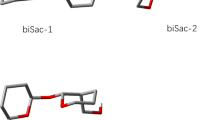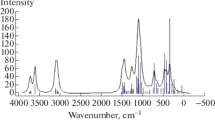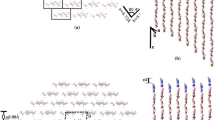Abstract
Energies for various trial packing arrangements of unit cells for the Iα and Iβ phases of native cellulose discovered by Sugiyamaet al. were evaluated. Both a rigid-ring method, PLMR, and the full-optimization, molecular mechanics program, MM3(90), were used. For both phases the models that had the lowest PLMR energy also had the lowest MM3 energy. Both calculated models have the chains packed ‘up’, O6s intg positions, and the same sheets of hydrogen-bonded chains. The Iβ structure model is essentially identical to that proposed previously for ramie cellulose by Woodcock and Sarko. It is also the same as the best parallel model previously proposed that was based on the X-ray data of Mann, Gonzalez and Wellard, once the various unit cell conventions are considered. Also, the energies from both methods for all three celluloses, Iα, Iβ and II, are in the order that rationalizes their relative stabilites.
Similar content being viewed by others
References
Aabloo, A. and French, A. D. Preliminary potential energy calculations of cellulose I crystal structure,Macromolek. Chem., Theory and Simulations, in press.
Allinger, N. L., Yuh, Y. H. and Lii, J.-H. (1989) Molecular mechanics. The MM3 force field for hydrocarbons.J. Amer. Chem. Soc. 111, 8551–8566.
Allinger, N. L., Rahman, M. and Lii, J.-H. (1990) A molecular mechanics force field (MM3) for alcohols and ethers.Ibid. 112, 8293–8307.
Arnott, S. and Scott, W. E. (1972) Accurate X-ray diffraction analysis of fibrous polysaccharides containing pyranose rings. Part I. The linked-atom approach,J. Chem. Soc. Perkin II, 324.
Atalla, R. H. and VanderHart, D. L. (1984) Native cellulose: a composite of two distinct crystalline forms.Science 223, 283.
French, A. D. and Howley, P. S. (1989) Comparisons of structures proposed for cellulose. In Cellulose and Wood — Chemistry and Technology (C. Schuerch, ed.). New York: Wiley, pp. 159–167.
French, A. D., Miller, D. P. and Aabloo, A. (1993) Miniature crystal models of cellulose polymorphs and other carbohydrates.Int. J. Biol. Macromol. 15, 30–36.
French, A. D., Roughead, W. A. and Miller, D. P. (1987) X-ray diffraction studies of ramie cellulose I.ACS Symposium Series 340, 15–37.
Honjo, G. and Watanabe, M. (1958) Examination of cellulose fibers by the low-temperature specimen method of electron diffraction and electron microscopy.Nature 181, 326–328.
Horii, F., Yamamoto, H., Kitamura, R., Tanahashi, M. and Higuchi, T. (1987) Transformation of native cellulose crystals induced by saturated steam at high temperatures.Macromolecules 20, 2946–2949.
Lii, J. H. and Allinger, N. L. (1991) The MM3 force field for amides, polypeptides and proteins.J. Comput. Chem. 12, 186–199.
Mann, J., Roldan-Gonzalez, L. and Wellard, H. J. (1960) Crystalline modifications of cellulose. Part IV. Determination of X-ray intensity data.J. Polym. Sci. 47, 165–171.
Mikelsaar, R.-H. (1986) New space-filling atomic-molecular models,Trends in Biotechnol. 4, 162–163.
Nishimura, H., Okano, T. and Sarko, A. (1991) Mercerization of cellulose. 5. Crystal and molecular structure of Na-cellulose I.Macromolecules 24, 759–770.
Nishimura, H. and Sarko, A. (1991) Mercerization of cellulose. 6. Crystal and molecular structure of Na-cellulose IV.Ibid.. 771–778.
Pertsin, A. J. and Kitaigorodsky, A. I. (1987)The Atom-Atom Potential Method Applications to Organic Molecular Solids, Springer Ser. Chem Phys., Vol. 43. Berlin: Springer Verlag.
Pertsin, A. J., Kitaigorodsky, A. I. and Marchenko, G. N. (1986) Crystal structure of cellulose polymorphs by potential energy calculations: 2. Regenerated and native celluloses.Polymer 27, 597–601.
Pertsin, A. J., Nugmanov, O. K., Marchenko, G. N. and Kitaigorodsky, A. I. (1984) Crystal structure of cellulose polymorphs by potential energy calculations: 1. Most probable models for mercerized cellulose.Ibid..25, 107–114.
Rånby, B. G. (1952) The mercerization of cellulose. I. A thermodynamic discussion.Acta Chem. Scand. 6, 101–115.
Sugiyama, J., Vuong, R. and Chanzy, H. (1991) Electron diffraction study on the two crystalline phases occurring in native cellulose from an algal cell wall.Macromolecules 24, 4168–4175.
VanderHart, D. L. and Atalla, R. H. (1984) Studies of microstructure in native celluloses using solid state13CNMR.Ibid..17, 1465–1472.
Wiley, J. H. and Atalla, R. H. (1987) Raman spectra of celluloses,ACS Symposium Series 340, 151–168.
Woodcock, C. and Sarko, A. (1980) Packing analysis of carbohydrates and polysaccharides. 11. Molecular and crystal structure of native ramie cellulose.Macromolecules 13, 1183.
Zugenmaier, P. and Sarko, A. (1980) The variable virtual bond,ACS Symposium Series 141, 226–237.
Author information
Authors and Affiliations
Rights and permissions
About this article
Cite this article
Aabloo, A., French, A.D., Mikelsaar, RH. et al. Studies of crystalline native celluloses using potential energy calculations. Cellulose 1, 161–168 (1994). https://doi.org/10.1007/BF00819665
Issue Date:
DOI: https://doi.org/10.1007/BF00819665




